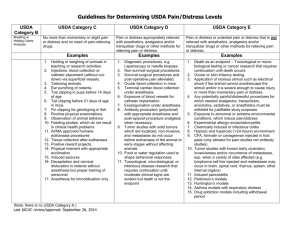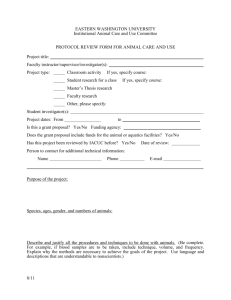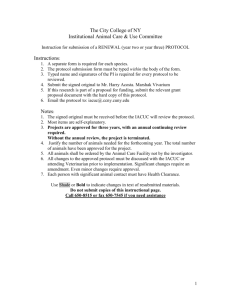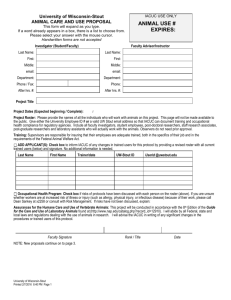Application to Use Animals in Research and Teaching
advertisement
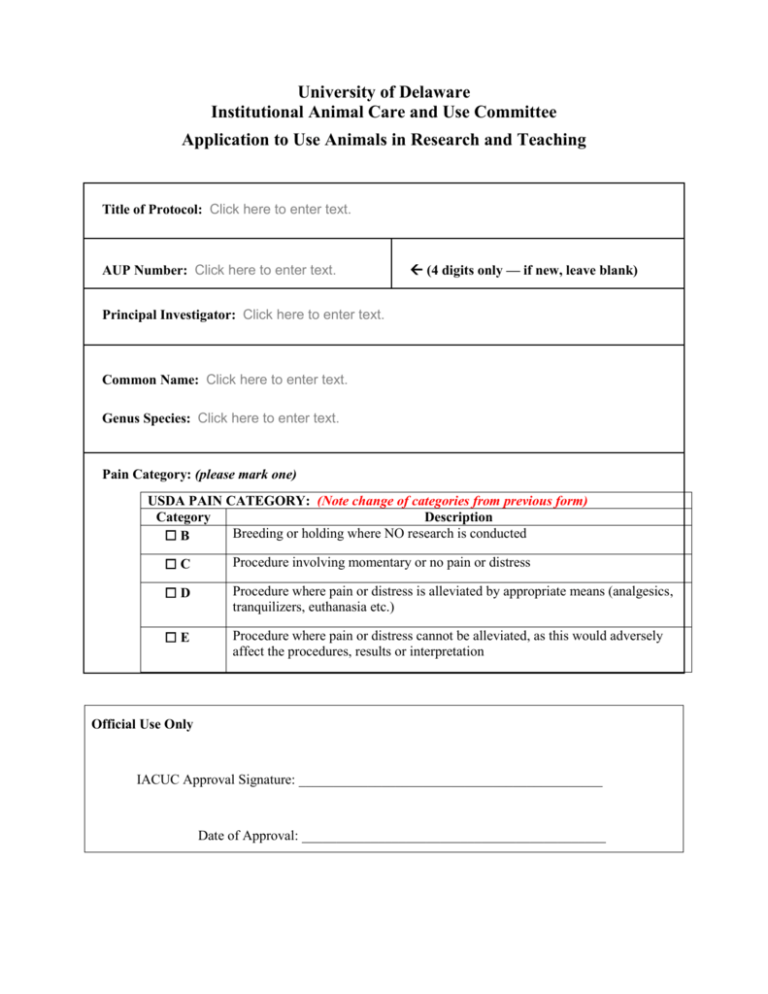
University of Delaware Institutional Animal Care and Use Committee Application to Use Animals in Research and Teaching Title of Protocol: Click here to enter text. AUP Number: Click here to enter text. (4 digits only — if new, leave blank) Principal Investigator: Click here to enter text. Common Name: Click here to enter text. Genus Species: Click here to enter text. Pain Category: (please mark one) USDA PAIN CATEGORY: (Note change of categories from previous form) Category Description Breeding or holding where NO research is conducted ☐B ☐C Procedure involving momentary or no pain or distress ☐D Procedure where pain or distress is alleviated by appropriate means (analgesics, tranquilizers, euthanasia etc.) ☐E Procedure where pain or distress cannot be alleviated, as this would adversely affect the procedures, results or interpretation Official Use Only IACUC Approval Signature: ____________________________________________ Date of Approval: ____________________________________________ Principal Investigator Assurance 1. I agree to abide by all applicable federal, state, and local laws and regulations, and UD policies and procedures. 2. I understand that deviations from an approved protocol or violations of applicable policies, guidelines, or laws could result in immediate suspension of the protocol and may be reportable to the Office of Laboratory Animal Welfare (OLAW). 3. I understand that the Attending Veterinarian or his/her designee must be consulted in the planning of any research or procedural changes that may cause more than momentary or slight pain or distress to the animals. 4. I declare that all experiments involving live animals will be performed under my supervision or that of another qualified scientist. All listed personnel will be trained and certified in the proper humane methods of animal care and use prior to conducting experimentation. 5. I understand that emergency veterinary care will be administered to animals showing evidence of discomfort, ailment, or illness. 6. I declare that the information provided in this application is accurate to the best of my knowledge. If this project is funded by an extramural source, I certify that this application accurately reflects all currently planned procedures involving animals described in the proposal to the funding agency. 7. I assure that any modifications to the protocol will be submitted to by the UD-IACUC and I understand that they must be approved by the IACUC prior to initiation of such changes. 8. I understand that the approval of this project is for a maximum of one year from the date of UDIACUC approval and that I must re-apply to continue the project beyond that period. 9. I understand that any unanticipated adverse events, morbidity, or mortality must be reported to the UD-IACUC immediately. 10. I assure that the experimental design has been developed with consideration of the three Rs: reduction, refinement, and replacement, to reduce animal pain and/or distress and the number of animals used in the laboratory. 11. I assure that the proposed research does not unnecessarily duplicate previous experiments. (Teaching Protocols Exempt) 12. I understand that by signing, I agree to these assurances. ________________________ Signature of Principal Investigator Rev 07/2015 ___________ Date 2 # NAMES OF ALL PERSONS WORKING ON THIS PROTOCOL I certify that I have read this protocol, accept my responsibility and will perform only those procedures that have been approved by the IACUC. Name Signature 1. Click here to enter text. 2. Click here to enter text. 3. Click here to enter text. 4. Click here to enter text. 5. Click here to enter text. 6. Click here to enter text. 7. Click here to enter text. 8. Click here to enter text. 9. Click here to enter text. 10. Click here to enter text. 11. Click here to enter text. 12. Click here to enter text. 13. Click here to enter text. 14. Click here to enter text. Rev 07/2015 3 # The Animal Use Protocol form has been developed to facilitate review of requests for specific research, teaching, or biological testing projects. The review process has been designed to communicate methods and materials for using animals through administrative officials and attending veterinarians to the Institutional Animal Care and Use Committee (IACUC). This process will help assure that provisions are made for compliance with the Animal Welfare Act, the Public Health Service Policy on Humane Care and Use of Laboratory Animals and the Guide for the Care and Use of Laboratory Animals. Please read this form carefully and fill out all sections. Failure to do so may delay the review of this application. Sections that do not apply to your research must be marked “NA” for “Not Applicable.” This application form must be used for all NEW or THREE-YEAR RENEWAL protocols. All answers are to be completed using Arial 12 size font. All questions must be answered in their respective boxes and NOT as attachments at the end of this form. Please complete any relevant addenda: Hybridoma/Monoclonal Antibodies (“B”) Polyclonal Antibodies (“C”) Survival Surgery (“D”) Non-Survival Surgery (“E”) Wildlife Research (“F”) If help is needed with these forms, contact the IACUC Coordinator at extension 2616, the Facility Manager at extension 2400 or the Attending Veterinarian at extension 2980. Rev 07/2015 4 # 1. Principal Investigator Information: Click here to enter text. a. Name: Click here to enter text. b. University/Company: Click here to enter text. c. Department: Click here to enter text. d. Building/Room: Click here to enter text. e. Office Phone: Click here to enter text. f. Lab Phone(s): Click here to enter text. g. Home Phone: Click here to enter text. h. Mobile Phone: Click here to enter text. i. E-Mail Address: 2. Protocol Status: a. ☐ New Protocol OR ☐ Re-submission due to three (3) completed years. If re-submission, enter Protocol Number: Click here to enter text. b. ☐ Research OR c. ☐ Laboratory Animals ☐ Teaching OR ☐ Wildlife If “Wildlife” please complete Addendum “F” d. Proposed Start Date: Click here to enter text. e. Proposed Completion Date: Click here to enter text. f. Funding Source: Click here to enter text. g. Award Number: Click here to enter text. 3. Personnel involved in Protocol (Include Principal Investigator): Status: Indicate Prof, Post-Doc, Grad Student, Lab Manager, Research Assistant, Technician, etc. Rev 07/2015 5 # Qualifications: Include procedures this person is proficient in performing on proposed species and the time they have been doing the procedure. Be specific (e.g. sub-mandibular bleeding on mice-2yrs, performing castrations on mice and rats-1yr, tailvein injections on mice-2yrs, etc.) (If no experience, list who will train.) Responsibilities: Include all responsibilities this person will have with live animals on this protocol, including euthanizing animals. E-mail Name a. Click here to enter text. Office Phone Number Click here to enter text. Home/Cell Phone Number Click here to enter text. Click here to enter text. E-mail Office Phone Number Home/Cell Phone Number Click here to enter text. Click here to enter text. Click here to enter text. E-mail Office Phone Number Home/Cell Phone Number Click here to enter text. Click here to enter text. Click here to enter text. Received Animal Facility Training Yes Click here to enter text. No Click here to enter text. Status: Click here to enter text. Qualifications: Click here to enter text. Responsibilities: Click here to enter text. Name b. Click here to enter text. Received Animal Facility Training Yes No Click Click here here to to enter enter text. text. Status: Click here to enter text. Qualifications: Click here to enter text. Responsibilities: Click here to enter text. Name c. Click here to enter text. Rev 07/2015 Received Animal Facility Training Yes No Click Click here here to to 6 # enter text. enter text. Status: Click here to enter text. Qualifications: Click here to enter text. Responsibilities: Click here to enter text. E-mail Office Phone Number Home/Cell Phone Number Click here to enter text. Click here to enter text. Click here to enter text. Name d. Click here to enter text. Received Animal Facility Training Yes No Click Click here here to to enter enter text. text. Status: Click here to enter text. Qualifications: Click here to enter text. Responsibilities: Click here to enter text. E-mail Office Phone Number Home/Cell Phone Number Click here to enter text. Click here to enter text. Click here to enter text. Name e. Click here to enter text. Received Animal Facility Training Yes No Click Click here here to to enter enter text. text. Status: Click here to enter text. Qualifications: Click here to enter text. Responsibilities: Click here to enter text. Name Rev 07/2015 Office Phone Number E-mail Home/Cell Phone Number Received Animal Facility Training Yes No 7 # f. Click here to enter text. Click here to enter text. Click here to enter text. Click here to enter text. Click here to enter text. Click here to enter text. Status: Click here to enter text. Qualifications: Click here to enter text. Responsibilities: Click here to enter text. E-mail Office Phone Number Home/Cell Phone Number Click here to enter text. Click here to enter text. Click here to enter text. Name g. Click here to enter text. Received Animal Facility Training Yes No Click Click here here to to enter enter text. text. Status: Click here to enter text. Qualifications: Click here to enter text. Responsibilities: Click here to enter text. E-mail Office Phone Number Home/Cell Phone Number Click here to enter text. Click here to enter text. Click here to enter text. Name h. Click here to enter text. Received Animal Facility Training Yes No Click Click here here to to enter enter text. text. Status: Click here to enter text. Qualifications: Click here to enter text. Responsibilities: Click here to enter text. Rev 07/2015 8 # 4. Non-Scientific Summary: In language understandable to a high-school senior, very briefly describe the goals and significance of this study. a. Specific Scientific Goals: Click here to enter text. b. Significance of this Research (including the possible benefits to human and/or animal health, the advancement of scientific knowledge, or the betterment of society): Click here to enter text. 5. Experimental Design: Explain the experimental design. This description should allow the IACUC to understand fully the experimental course of an animal or group of animals from its entry into the experiment to the endpoint of the study. The inclusion of flow charts, diagrams, and/or tables are greatly encouraged to explain experimental design or sequential events. Be sure to include all animal events and related details, i.e., All Procedures-bleedings, injections, identification methods, genotyping methods, surgical procedures, euthanasia, etc. Procedural details–number of animals involved in procedure, approximate animal weight, if relevant (for injections, bleeding, etc.), route, frequency, volume, etc. Pharmaceutical-grade and non-pharmaceutical grade compounds – Identify any drugs, biologics, or reagents that will be administered to animals. Names of surgical procedures (but reserve the surgical details for the proper Surgical Addenda) Monitoring–observations, measurements (animal weight, tumor size, etc.) Monitoring details–criteria, frequency, names of personnel monitoring, conditions for removing an animal from the study, etc. Endpoints–include endpoints for the animals/study and how will they be determined. (Describe): Click here to enter text. REFINEMENT, REDUCTION & REPLACEMENT When using animals for research, it is important to consider the three Rs: reduction, refinement, and replacement to reduce both animal distress and the number of animals used in the laboratory. Reduction: Minimizing the number of animals used Refinement: Using techniques and procedures to reduce pain and distress Replacement: Using non-animal methods or lower phylogenetic organisms 6. Justification for the Use of Animals (instead of in vitro methods) (Check all that apply and explain): a. ☐ The complexity of the processes being studied cannot be duplicated or modeled in simpler systems: (Explain): Click here to enter text. Rev 07/2015 9 # b. ☐ There is not enough information known about the processes being studied to design non-living models: (Explain): Click here to enter text. c. ☐ Other: (Explain): Click here to enter text. 7. Justification for Species Appropriateness: (Check all that apply and explain): a. ☐ A large database exists, allowing comparisons with previous data: (Explain): Click here to enter text. b. ☐ The anatomy or physiology is uniquely suited to the study proposed: (Explain): Click here to enter text. c. ☐ This is the lowest species on the phylogenic scale suitable to the proposed study: (Explain): Click here to enter text. d. 8. ☐ Other: (Explain): Click here to enter text. Justification for Number of Animals Requested: (Note: numbers should include animals used for breeding and all animals born) a. ☐ Pilot study or preliminary project where group variances are unknown at the present time. Describe the information used to estimate how many animals will be needed: (Only a limited number of animals will be permitted.) (Explain): Click here to enter text. Rev 07/2015 10 # b. ☐ Group sizes are determined statistically. Describe the statistical analysis used to estimate the number (N) of animals needed: N may be estimated from a power analysis for the most important measurement in the study, usually based on the expected size of the treatment effect, the standard error associated with the measurement, and the desired statistical power (e.g. P < 0.05). Data analysis methods should not be submitted unless directly applicable to the estimate of N. An online calculator may be found at: http://www.math.uiowa.edu/~rlenth/Power/ or a stand-alone calculator that can be downloaded from http://www.psycho.uni-duesseldorf.de/abteilungen/aap/gpower3 (Explain): Click here to enter text. c. ☐ Group sizes are based on the quantity of harvested cells or the amount of tissue required for in vitro studies. Explain how much tissue is needed based on the number of experiments to be conducted and the amount of tissue you expect to obtain from each animal (e.g., 10g of tissues are needed: Each animal can provide 2g. 10g /2g per animal = 5 animals needed.) (Explain): Click here to enter text. d. ☐ Teaching protocol. Specify the number of students in the class, the student to animal ratio and how that ratio was determined: Animal numbers should be minimized to the fullest extent possible without compromising the quality of the hands-on teaching experience for students or the health and welfare of the animals. (Explain): Click here to enter text. e. ☐ Study involving feral or wild animals. Animals will be captured and released in an attempt to maximize the sample size within logistical constraints. Describe the process by which you estimate these numbers and estimate the precision needed: (Explain): Click here to enter text. f. ☐ Observational, non-manipulative study. Animals will not be captured, their behavior will not be interfered with, and exact animal numbers cannot be predicted: (Explain): Click here to enter text. g. ☐ Product testing. The number of animals needed is based on FDA guidelines. Provide the citation from the regulations, the IND tracking number, or relevant FDA correspondence: (Explain): Click here to enter text. h. ☐ Other. Elaborate, indicating the method used to determine the group size. (Explain): Click here to enter text. Rev 07/2015 11 # 9. Animals Requested: Common Name 10. Genus and Species Total Number of Animals for Three Years 1. Click here to enter text. Click here to enter text. Click here to enter text. 2. Click here to enter text. Click here to enter text. Click here to enter text. 3. Click here to enter text. Click here to enter text. Click here to enter text. 4. Click here to enter text. Click here to enter text. Click here to enter text. 5. Click here to enter text. Click here to enter text. Click here to enter text. 10. Where will animals be housed (or captured for wildlife)? Click here to enter text. 11. Where will the experiments take place? If animals must be removed from the vivarium, please describe how they will be transported (such as hand carried in covered microisolator cages). Click here to enter text. 12. Will any animals be humanely killed, without treatment or manipulations, to be used to obtain tissue, cells, etc.? ☐ Yes ☐ No If Yes, list types of tissue, etc: Click here to enter text. 13. Physiological Measurements ☐ Yes ☐ No If Yes, list and explain: Click here to enter text. 14. Dietary Manipulations ☐ Yes ☐ No If Yes, list and explain (Note: if food or fluid will be restricted, describe method for assessing the health and wellbeing of the animals. Body weights must be recorded at least weekly. Amount earned (if animals work for food or fluid) during testing and amount freely given must be recorded. A scientific justification must be provided for departures from the recommendations of the Guide.) Click here to enter text. Rev 07/2015 12 # 15. ☐ Yes Environmental Stress (e.g. cold, restraint, forced exercise) ☐ No If Yes, list and explain: Click here to enter text. 16. Trauma or Burn Injury ☐ Yes ☐ No If Yes, list and explain: Click here to enter text. 17. Production of Hybridoma/Monoclonal Antibodies ☐ Yes ☐ No If Yes, please complete Addendum “B”. 18. Production of Polyclonal Antibodies ☐ Yes ☐ No If Yes, please complete Addendum “C”. 19. Administration of Hazardous Chemicals, Drugs, Toxins, or Nanoparticles ☐ Yes CAS#______ ☐ No If Yes, describe hazards posed to personnel: Click here to enter text. Methods to control exposure: Click here to enter text. Methods of Disposal of Animals and Bedding: Click here to enter text. 20. Administration of radioactive materials ☐ Yes ☐ No a. Type to be used. Include radioisotope(s) and chemical form(s): Click here to enter text. b. Describe the practices and procedures to be followed for minimization of radiation exposure to workers and for the handling and disposal of contaminated materials associated with this study: (Include the methods for management of radioactive wastes and monitoring facility for radioactive contamination, if applicable.) Click here to enter text. c. Who will be responsible for the daily care of animals containing radioactive materials? Click here to enter text. d. Approval received from UD- Environmental Health and Safety? ☐ Yes ☐ No ☐ Pending Rev 07/2015 13 # Click here to enter text. Please attach a copy of any approvals or provide the approval number. Click here to enter text. 21. Study of Irradiation in vivo? ☐ Yes (gamma irradiator? or x-ray irradiator? ) ☐ No a. Make, model, and location of irradiator to be used: Click here to enter text. b. Approval received from UD- Environmental Health and Safety? ☐ Yes ☐ No ☐ Pending Please attach a copy of any approvals or provide the approval number.Click here to enter text. 22. Administration of Biological Agents (eg microorganisms, recombinant DNA, HUMAN serum, tissue, cell lines, etc.) ☐ Yes ☐ No Animal Biosafety Level ☐ 1 ☐2 ☐3 ☐4 Describe hazards posed to personnel:Click here to enter text. Methods to control exposure:Click here to enter text. Methods of Disposal of Animals and Bedding:Click here to enter text. Approval received from UD- Institutional Biosafety Committee? ☐ Yes ☐ No ☐ Pending Please attach a copy of any approvals or provide the approval number. Click here to enter text. 23. Will tumor cells, tissue, sera, viral vectors or other biologics of RODENT origin – other than those isolated from rodents already housed in the facility – be administered to animals? ☐ Yes ☐ No If Yes, this material must be tested for rodent pathogens and test results must be attached (Please contact the Attending Veterinarian for details). Click here to enter text. 24. Use of Genetically Engineered Animals ☐ Yes ☐ No If Yes, please describe any anticipated phenotypes that may cause pain or distress and any special monitoring that the animals will require. care or Click here to enter text. Does the proposed work involve creating new genetically modified animals, or involve crossing two Rev 07/2015 14 # genetically modified animals to produce offspring with a new genotype. ☐ Yes ☐ No Approval received from UD- Institutional Biosafety Committee? ☐ Yes ☐ No ☐ Pending ☐ Exempt (breeding of two lines of genetically-modified rodents is exempt if 1) both parents can be housed under BL1 containment and 2) neither parent strain incorporates more than one half of the genome of an exogenous eukaryotic virus or incorporates a transgene under the control of a gammaretroviral long terminal repeat and 3)the rodent that results from the breeding is not expected to contain more than one half of an exogenous viral genome) Please attach a copy of any approvals or provide the approval number. ________________Click here to enter text.___________ 25. Special Study Requirements: Please describe any special study requirements such as a requirement for single housing of the animals, exemption from environmental enrichment, or special caging:Click here to enter text. 26. Are any drugs biologics or reagents administered to animals non-pharmaceutical grade compounds? ☐ Yes ☐ No If Yes, explain and describe method to ensure appropriate preparation: (for example: pharmaceutical grade drugs are not available. Sterile saline will be used as a vehicle and the solution will be sterile-filtered): Click here to enter text. 27. Will this study involve surgery? ☐ Yes ☐ No If Yes, and it is “Survival Surgery,” please complete Addendum “D”. If Yes, and it is “Terminal Surgery,” please complete Addendum “E”. 28. Will any animal undergo anesthesia for any reason other than surgery? Yes No If Yes, a. List Procedures and Reason(s) for using anesthesia: Click here to enter text. b. Check the type of anesthesia to be used. ☐ Isoflurane ☐ Injectable (For injectable, complete the following): Drug: Click here to enter text. Dose: Click here to enter text. Rev 07/2015 15 # Route: Click here to enter text. 29. Animal Use and Pain Distress. If you have indicated that animals in your study will experience pain or distress, even if it will be fully alleviated, please mark the appropriate check boxes below and fill in the requested information for each item marked. You must conduct at least two (2) searches. I have considered alternatives to the use of animals in my study. Alternatives refer to methods or approaches which result in refinement of procedures which lessen pain and/or distress; reduction in numbers of animals required; or replacement of animals with non-whole-animal systems or replacement of one animal species with another, particularly if the substituted species is nonmammalian or invertebrate. I have used the following methods and sources to search for alternatives: Note: You may need to do more than one search per database to look for alternatives if there are multiple procedures that may cause pain and/or distress. Database Used: ☐ Medline ☐ Agricola ☐ Toxline ☐ CAB Abstracts ☐ Biosis ☐ Other (Specify): Click here to enter text. Date of Search: Click here to enter text. Years Covered: Click here to enter text. Keywords Used (must include the word alternative): Click here to enter text. Number of Papers Found: Click here to enter text. Discussion of the Relevancy of the Papers Found: Click here to enter text. Database Used: ☐ Medline ☐ Agricola ☐ Toxline ☐ CAB Abstracts ☐ Biosis ☐ Other (Specify): Click here to enter text. Date of Search: Click here to enter text. Years Covered: Click here to enter text. Keywords Used (must include the word alternative): Click here to enter text. Number of Papers Found: Click here to enter text. Discussion of the Relevancy of the Papers Found: Click here to enter text. Rev 07/2015 16 # 30. Unnecessary Duplication of Work. Activities involving animals must not unnecessarily duplicate previous experiments performed by you or others. Provide a written narrative that assures that the activities of this project comply with this requirement and support this assurance by performing a literature search. The search should return, at minimum, the related previous work from your laboratory. You must conduct at least two (2) searches. (NOT REQUIRED FOR TEACHING PROTOCOLS) Note: You may need to do more than one search per database to look for duplication of work, especially if you are doing more than one experiment. Database Used: ☐ Medline ☐ Agricola ☐ Toxline ☐ CAB Abstracts ☐ Biosis ☐ Other (Specify): Click here to enter text. Date of Search: Click here to enter text. Years Covered: Click here to enter text. Keywords Used: Click here to enter text. Number of Papers Found: Click here to enter text. Discussion of the Relevancy of the Papers Found: Click here to enter text. Database Used: ☐ Medline ☐ Agricola ☐ Toxline ☐ CAB Abstracts ☐ Biosis ☐ Other (Specify): Click here to enter text. Date of Search: Click here to enter text. Years Covered: Click here to enter text. Keywords Used: Click here to enter text. Number of Papers Found: Click here to enter text. Discussion of the Relevancy of the Papers Found: Click here to enter text. 31. What is the expected disposition of animals at the end of the experiments? Rev 07/2015 17 # (Check all that apply): ☐ Euthanized ☐ Maintained ☐ Released (Wildlife Only) ☐ Other (Specify): Click here to enter text. 32. Euthanasia* Select methods that will be used in case of emergency and/or at the end of the procedure/experiment. *NOTE: Methods must be approved by the AVMA or must be scientifically justified. A “Primary” and “Secondary” method must be selected (UD Double Kill Policy). If different methods will be used for different groups of animals, indicate the group after the procedure (e.g., write “Neonates” after Decapitation, “Adults” after CO2, “Terminal Surgery Animals” after Isoflurane Anesthesia Overdose, etc.). ☐ Animals will NOT be under anesthesia when euthanasia is performed. ☐ Animals will be under anesthesia when euthanasia is performed. (Check drug used below): ☐ Isoflurane ☐ Injectable (Complete the following): Drug: Click here to enter text. Dose: Click here to enter text. Route: Click here to enter text. PRIMARY method(s) of euthanasia ☐ CO2 by compressed gas cylinder (Not for animals already under anesthesia or neonates) ☐ Barbiturate Euthanasia Solution - Injectable ≥150mg/kg (Check route below): ☐ IV ☐ IP ☐ IC ☐ Isoflurane Anesthesia Overdose - Inhalant ☐ Cervical Dislocation (only under anesthesia) ☐ Decapitation (only under anesthesia or neonates) ☐ Exsanguination or Perfusion (only under anesthesia) ☐ Incision of Chest Cavity – Bilateral Pneumothorax (only under anesthesia) ☐ Pithing – (only under anesthesia) ( amphibians, reptiles only) Rev 07/2015 18 # ☐ Removal of Vital Organ(s) (only under anesthesia) (Check all that apply): ☐ Brain ☐ Kidneys ☐ Heart ☐ GI Tract ☐ Liver ☐ Lungs ☐ Other Vital Organ(s) – (Specify): Click here to enter text. ☐ Other Method of Euthanasia: (Describe and Scientifically Justify): SECONDARY method(s) of euthanasia that will be used to ensure that the animal does not survive: ☐ Cervical Dislocation ☐ Decapitation ☐ Exsanguination or Perfusion ☐ Incision of Chest Cavity – Bilateral Pneumothorax ☐ Barbiturate Euthanasia Solution - Injectable ≥150mg/kg (Check route below): ☐ IV ☐ IP ☐ IC ☐ Pithing – Double pithing required (fish, amphibians, reptiles only) ☐ Removal of Vital Organ(s): (Check all that apply): ☐ Brain ☐ Kidneys ☐ Heart ☐ GI Tract ☐ Liver ☐ Lungs ☐ Other Vital Organ(s) – (Specify): Click here to enter text. ☐ Other Method of Euthanasia: (Describe and Scientifically Justify): Click here to enter text. Rev 07/2015 19 #

